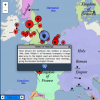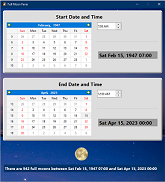Web Apps
These little apps are built using Progressive Web Application technology, so they run on all modern browsers. Click the icon in the left panel, or the “Visit Web Site” link in the right panel.
EQTrace - An Interactive Worldwide Earthquake Atlas
EQTrace displays selected earthquake events from the publicly-available Earthquake Catalog portal of the United States Geological Survey (USGS) website, which contains quake records from January, 1900 to the present. Enter a date range, or specify all quakes within the previous week, day, or hour, select a magnitude and depth range, and optionally limit the search to a selected quadrangular geographic region. The app retrieves the desired set of quakes from the USGS database, and displays them on a 2-dimensional map or a 3-dimensional globe using colored markers that indicate quake location, magnitude and depth. You can view either a static display or run a simulation to show quake events as they occurred in chronological order.
This app is in production; Version 1.1 is available in the Microsoft Store.
EuroWarsAtlas - An Atlas of Conflicts in Europe and the Middle East, 1000 A.D. - 1700 A.D.
EuroWarsAtlas is an interactive map and database of major Conflicts occurring in Europe, the Middle East and western Asia between the years 1000 A.D. and 1700 A.D. Choose from a number of different Conflicts (for example, Hundred Years War, Italian Wars, Reconquista, etc), or specify a Date Range, or search for events containing a Keyword string in the title or description. The resulting battle events are represented on a 2-D map using markers to define the location. Click a marker to view details on the battle, and to access links to relevant imagery and Wikipedia articles. The Eurowars database contains over 1400 battle events and 388 digitized colored maps.
This app is in development; there is still much work to do in synthesizing descriptive historical information, and there are a few minor bugs. It is best suited for desktop displays, running the app in full screen mode in your favorite browser.
Time2Time - An Event Time Difference Calculator
Time2Time calculates the elapsed time between two Events (points in time). Once both the Start Event and End Event times are specified, the Calculator displays the time difference in years, months, days, hours, minutes and seconds. You specify Event date/time in any of three ways: Manual Entry Mode sets an Event through manual selection of the month, day, and year, and optionally the Event hour, minute and second; Current Time Mode sets an Event to the current local date and time, and Select Event mode allows you to choose from a list of existing Events. You can save any Event in Manual Entry mode for use in another session (for example, birthdays, major life events, etc). All dates between 1700 A.D. and 2200 A.D. are supported. You can specify an Event as occurring in any of the 37 internationally recognized Time Zones. The app also supports Daylight Savings Time (refer to the Documentation for details as well as caveats for all of these features).
The app is implemented for desktop browsers, tablets, and mobile devices, although it’s best viewed on a large display screen. You may also download it as a Progressive Web Application on browsers that support PWA capabilities (all modern browsers support PWA technology).
Enhancements for global clock corrections, (such as leap seconds and other anomalous conditions), is under development. The app currently assumes that all Event dates are with respect to the modern (Gregorian) Calendar.
PowerPlants - An Atlas of Worldwide Powerplants
PowerPlants displays the geographic location and physical attributes of nearly 30,000 Powerplants located throughout the world that have a minimum capacity of 1 Megawatt (MW) (approximately 82% of the world’s capacity). Plants are categorized by fuel type (biomass, coal, co-generation, natural gas, geothermal, hydroelectric, nuclear, oil, solar, waste, wave, and wind). You can specify search criteria by fuel type and by capacity range. The app also allows selecting plants by geographic region or by selected specific countries, or by defining a custom quadrangular region on the map.
The app is implemented for desktop browsers, tablets, and mobile devices, although it’s best viewed on a large display screen. You may also download it as a Progressive Web Application on browsers that support PWA capabilities (all modern browsers support PWA technology).
The source of data is a local copy of the Global Power Plant Database, a comprehensive, global, open source database of power plants:
- Version: 1.3.0
- Release Date: 2021-06-12
- Copyright 2018-2021 World Resources Institute and Data Contributors
- URI: http://datasets.wri.org/dataset/globalpowerplantdatabase
FirstStreet Risks - Risk of Fire, Flood, Heat and Wind by U.S. Census Tract
FirstStRisks combines U.S. Census Bureau information along with environmental risk data calculated by the First Street Foundation and presents it in a map display. Data is represented at the Census Tract level (2020). You may elect to display the information by entering an address or by selecting your current location. Alternatively, you may display ALL tracts for a selected U.S. State, and navigate to a specific tract using standard map controls.
Environmental risks include likelihood of damage due to fire, flood, heat and wind, on a scale of 1 to 10.
The source of data is U.S. Census Bureau Geocoder and a local copy of the First Street Foundation data source.
Installable Apps
These apps can be downloaded and run on Windows platforms (Windows 8 through 11) using a standard wizard installer.
These apps can be downloaded and run on Windows platforms (Windows 8 through 11) using a standard wizard installer.
FullMoonFever - Number of Full Moons between Dates
FullMoonFever - Number of Full Moons between Dates
How many full moons have occurred between your birthday and today? (You’ll reach your 1000th at some date between your 80th and 81st birthday). The FullMoonFever app calculates the number of full moons occurring between any two dates of your choosing, using the lunar synodic period of 29.53059 days and the date of the first full moon in the 20th Century (January 15, 1900, at 19:06 GMT) to derive successive (or previous) full moon dates.
All dates/times are with respect to Greenwich Meridian Time (GMT) and assume that both start and end dates conform to the Gregorian Calendar.



